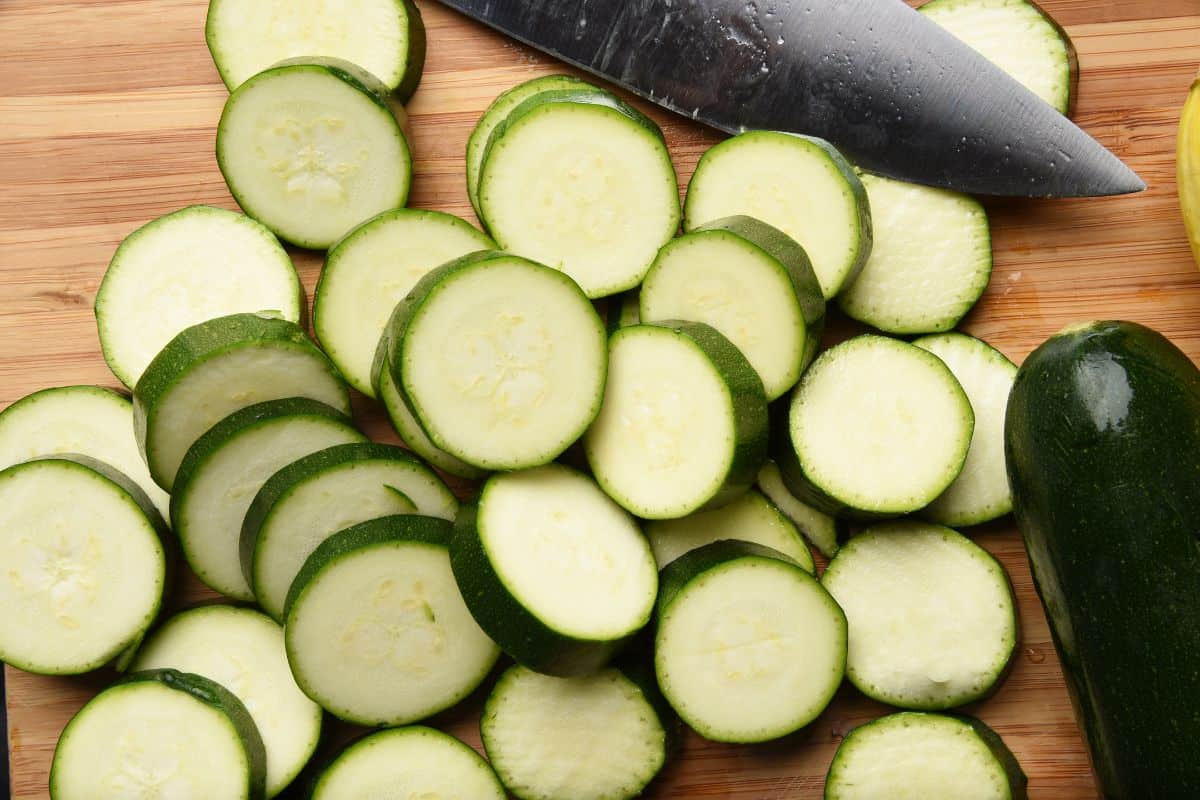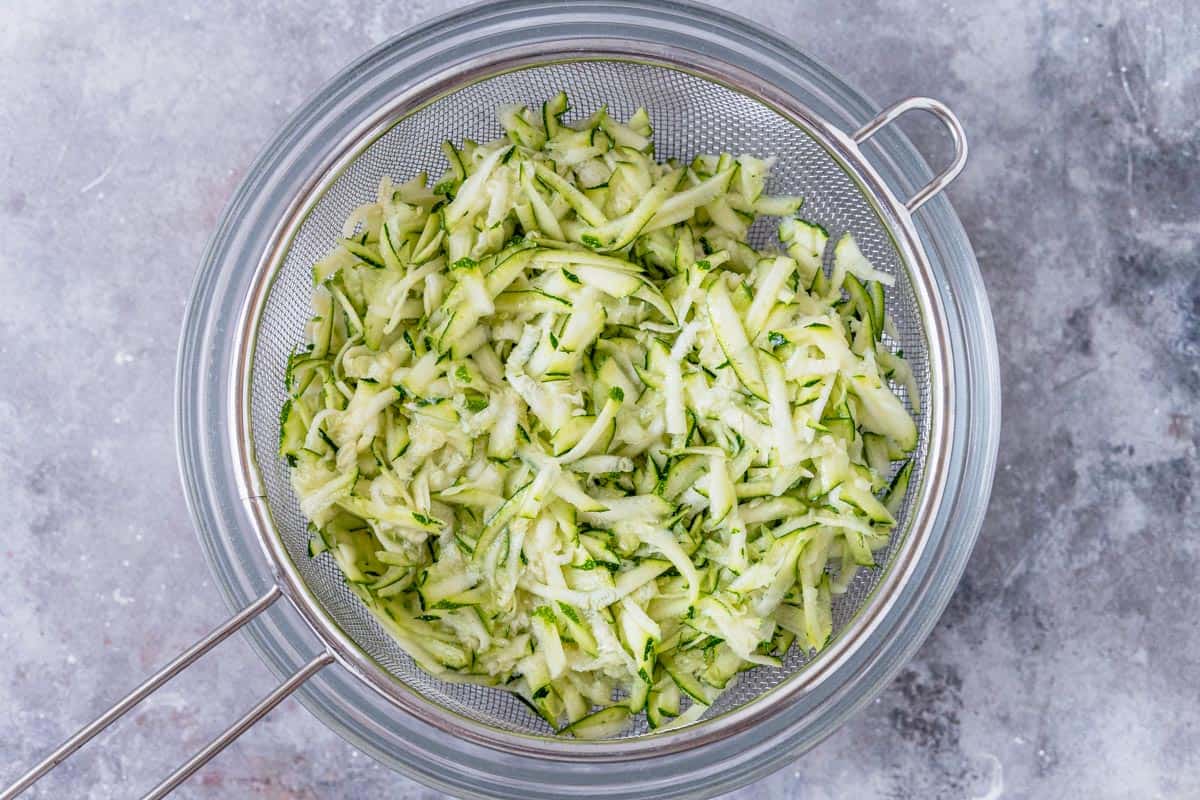Zucchini is a fantastic summer squash to incorporate into both sweet and savory dishes. Its mild flavor means it can be paired with a variety of ingredients while it also provides natural liquid and healthy dietary fiber.
Learning how to store zucchini properly will ensure the best results in your recipes that call for zucchini.

From storing in the fridge to freezing, canning, and even dehydrating - there’s bound to be a method of storage that suits your needs!
Selecting Zucchini
Selecting quality zucchini from your local grocery store or farmers' market will have a direct impact on how long will zucchini last.
- Always choose zucchinis that feel heavy as this is a good indicator that they are fresh and full of healthy juice.
- The skin of the zucchini should be smooth and without spots or blemishes.
Want to Save This Recipe?
Enter your email and we’ll send the recipe directly to you!
By submitting this form, you consent to receive emails from The Yummy Bowl.
Different Ways To Storing Zucchini
Storing Fresh Zucchini
Fresh and whole zucchini should be stored in a perforated sealable bag in a designated vegetable drawer or in the fridge. The perforated bag allows air circulation to prevent mold from developing.
If you wash your zucchini before storing it, make sure that you dry it properly with a paper towel before storing it. Any excess moisture can lead to mold.
When stored properly, fresh whole zucchini will last for 2 weeks.
How To Store Fresh And Cut Zucchini
Leftover cut zucchini from making other recipes should be stored in the fridge for only a few days to avoid it from becoming overly soft and losing flavor.
You can wrap the cut zucchini in plastic wrap and aluminum foil, paper bag or simply store it in an airtight container.
How To Store Zucchini In The Freezer
Read on how to freeze chopped, shredded zucchini or zoodles.
To Freeze Cut Slices of Zucchini
- Wash & slice: First, wash the zucchini in cold water and then slice it into thicker circles or cubes/triangles.
- Blanch: Before storing the cut zucchini, take the extra step to blanch it in boiling water for 1-2 minutes and then transfer it with a slotted spoon to a large bowl of ice water to stop any further cooking. This process helps deactivate the enzymes responsible for causing mushy zucchini after freezing. Additionally, freezing vegetables at their peak freshness preserves all nutrients.
- Dry: Remove zucchini slices from the water and drain the blanched zucchini with paper towels. This method helps to prevent freezer burn on the zucchini! Avoid leaving it in the ice water for an extended period. Ensure the zucchini is no longer hot, though it doesn't need to be entirely cool yet. This prevents it from absorbing excess water.
- Flash freeze: Place the dry zucchini in a single layer on a parchment-lined baking sheet. This prevents them from freezing into a solid lump in your storage bag.
- Store it in an airtight plastic bag or container with a label to add a date. You can store the zucchini in your freezer for up to 3 months. While technically still edible after this time, the taste and texture may be affected by freezer burn.
- Defrost: Remove the slices from the freezer and place them in the fridge overnight to thaw. Reheat in microwave or add to soups, pastas and stir fries.
To Freeze Shredded Zucchini
This technique works well for recipes calling for shredded zucchini, such as zucchini muffins.
- Grate: Grate your zucchini, leaving the peel on, using either a box grater or a food processor with a grating attachment. If you're using a large zucchini, chop it into manageable-sized pieces. However, if you're using small zucchinis that you can easily hold with one hand, there's no need to cut them.
- Wring out the excess moisture: Place a clean dish towel over a large pot or bowl with colander in between, and spread the shredded zucchini on top of the towel. Add 1 tablespoon of salt (for every 2 cups of zucchini) and with your hands knead grated zucchini until everything is covered in salt and bubbly. The salt will helps to remove excess water and aids in preserving your grated zucchini texture while storing. Do this for 5 minutes and then let the zucchini sit for 10-15 minutes. When ready, gather the corners of the towel and wring out the excess moisture into the bowl. Discard the water.
- Dry: Allow the shredded zucchini to dry in the cloth for at least 1 hour. This allows any remaining liquid to drain out, resulting in tastier zoodles when frozen and thawed. But if pressed on time, you can skip this step.
- Flash freeze: Transfer all the shredded zucchini into your preferred size cubes (I like Souper Cubes trays). Freeze the zucchini in the trays for a minimum of 4 hours. Or you can directly add the shredded zucchini to a compressed ziplock bag and freeze this way, however flash freezing first is easier to defrost later.
- Transfer to containers: Once frozen, remove the zucchini cubes from the trays and transfer them into freezer bags for long-term storage. You can store them for up to 3-6 months, however the zucchini may become less flavorful over time.
- Defrost: To use your frozen zucchini, place the removed zucchini blocks in a colander set over a bowl. This allows the defrosting zucchini to release moisture into the bowl, preventing it from reabsorbing into the thawed zucchini. Add grated zucchini to your favorite muffins, quick breads, soups or smoothies.

To Freeze Zoodles
- Dry and add to a bowl: Place your zucchini noodles in a large bowl. Before freezing, ensure to thoroughly dry them. Moist zoodles can lose their shape and texture during storage, resulting in a soggy and unappetizing outcome when thawed.
- Salting: Sprinkle kosher salt evenly over your zoodles. Use roughly 1 US tablespoon of kosher salt for every 2 cups of zoodles. Pinch the salt between your fingers and sprinkle it over the zucchini noodles, covering as much surface area as possible. Knead your zoodles thoroughly, ensuring they are well coated with salt. Squeeze and turn the zucchini noodles in the bowl repeatedly, adding more salt as needed to cover any bare areas. Continue this process until salt grains are visible on every zoodle.
- Drain: Place a clean dish towel over a large pot or bowl lined with a clean cloth or towel and colander, and spread on top wrapping them completely with the cloth to create a makeshift bag. Use pins or clamps if necessary to secure the cloth. Squeeze the cloth bag to remove excess moisture, pressing with both hands for about 2 minutes or until the liquid stops running.
- Allow to dry: Allow the zoodles to dry in the cloth for at least 1 hour. This allows any remaining liquid to drain out, resulting in tastier zoodles when frozen and thawed.
- Freeze: Transfer your zoodles into small, freezer-safe bags. After removing the zucchini noodles from the fabric, lay them out on a clean surface. If they appear dry enough, divide them into several small freezer-safe bags. You can store them for up to 3-6 months, however the zoodles may become less flavorful over time.
- To Defrost: To thaw your zoodles, bring a pot of water to a boil. Once boiling, place your zucchini noodles in a strainer basket and submerge them in the water for about 1 minute. Use zoodles to make a zucchini pasta, salad, or stir fries.
Does Zucchini Last Longer on the Counter or in the Fridge?
You have the freedom to store your zucchini either on the counter or in the fridge - it's your choice.
However, I recommend storing your zucchini in the fridge or a root cellar to keep them fresh longer and prevent bacterial growth. If left on the counter, they'll soften faster, so use them promptly.
Signs That Your Fresh-Stored Zucchini Is Turning Bad
It’s important to check on your freshly stored zucchini regularly. Use up any zucchinis that start to soften or wrinkle.
If you have an abundance of zucchini that you know you won’t be using in time, consider gifting them to your neighbors, friends, or family, or freezing them.
How To Harvest And Store Fresh Zucchini From The Garden
If you have green fingers and grow your own zucchini plants, knowing the proper harvesting techniques to use will extend the storage of your fresh zucchini!
It’s best to harvest young and tender zucchini that measure about 6-8 inches in length.
Larger zucchini become less flavorful and have a high water content which isn’t ideal for storage.
When picked, wash and dry the zucchini so that no extra moisture remains. Store them as you would store store-bought fresh zucchini.
🥒 Read also: 18 Types of Zucchini You Didn't Know About
Should You Wash Your Zucchini Before Storing?
The key to prolonging the freshness of stored zucchini lies in maintaining its dryness.
Instead of washing, use a paper towel to wipe down the zucchini, ensuring the removal of any moisture, dirt, or debris from the garden.
Save the proper washing for when you're prepared to use them—it's the optimal time for thorough cleaning.

Other Methods For Storing Zucchini
Apart from storing fresh zucchini or freezing it, there are two other popular methods for storing your zucchini that you may like to try:
Canning Zucchini
Canning is a great method for storing zucchini for up to a year!
You’ll need canning jars, a pressure canner, and a step-by-step guide to take you through the correct canning procedures to prevent the growth of harmful bacteria.
Dehydrating Zucchini
Drying zucchini through dehydration techniques and equipment can also preserve the zucchini for quite some time.
Dehydrated zucchini is a great option for making zucchini chips that can be served with hummus or other dips as a party appetizer or snack.
You can also dehydrate your zucchini and store it in the pantry for use in your favorite soup and stews.
To dry the zucchini, slice it thinly into uniform thin slices and then arrange the sliced zucchini in a single layer on dehydrator trays, leaving enough space between the slices for proper air circulation.
Dehydrate the zucchini slices at 125F or until crispy.
These can then be stored (once cool) in sealable bags or an airtight container in a cool, dry place.
Rehydrate the zucchini slices by soaking them in warm water for 15-20 minutes prior to use.
Best Recipes With Zucchini
Common Questions
Thawing beforehand isn't essential when incorporating zucchini slices into soup. Yet, if you plan to sauté them in a skillet or add shredded zucchini to bread or muffin batter, I recommend defrosting them first.
Like thawing other frozen vegetables, you can defrost the zucchini by placing the frozen bag in the refrigerator overnight, soaking it in room temperature water for a few hours, or using the microwave.
Freezing zucchini without boiling or cooking it is entirely feasible.
Rather than slicing, opt to grate or shred the zucchini before freezing. This technique of storage can help you save a substantial amount of time.
Did you like this article?
Please leave a comment and share it on Instagram, Facebook, and Pinterest!


Julia | The Yummy Bowl
Properly storing zucchini will prolong its shelf life.